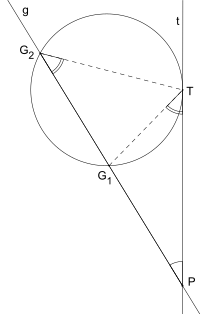Tangent-secant theorem
The tangent-secant theorem describes the relation of line segments created by a secant and a tangent line with the associated circle.
Given a secant g intersecting the circle at points G1 and G2 and a tangent t intersecting the circle at point T and given that g and t intersect at point P, the following equation holds:
The tangent-secant theorem can be proven using similar triangles (see graphic). Construct the diameter passing through point T, say it meets the circle at point D. Now, angles G1DT and G1G2T are equal because they subtend the same arc of the circle. Triangle DG1T is a right angled triangle because the inscribed angle DG1T subtends a diameter DT. Since angle DTP is a right angle, angle PTG1 is equal to G1DT and hence equal to G1G2T. Therefore the triangles PG1T and PTG2 are similar, since two of their angles are equal, and thus corresponding sides of the triangles are proportional.
Like the intersecting chords theorem and the intersecting secants theorem, the tangent-secant theorem represents one of the three basic cases of a more general theorem about two intersecting lines and a circle, namely, the power of point theorem.
References
- S. Gottwald: The VNR Concise Encyclopedia of Mathematics. Springer, 2012, ISBN 9789401169820, pp. 175-176
- Michael L. O'Leary: Revolutions in Geometry. Wiley, 2010, ISBN 9780470591796, p. 161
- Schülerduden - Mathematik I. Bibliographisches Institut & F.A. Brockhaus, 8. Auflage, Mannheim 2008, ISBN 978-3-411-04208-1, pp. 415-417 (German)
External links
- Tangent Secant Theorem at proofwiki.org
- Power of a Point Theorem auf cut-the-knot.org
- Alternate Segment Theorem at brilliant.org
- Weisstein, Eric W. "Chord". MathWorld.
